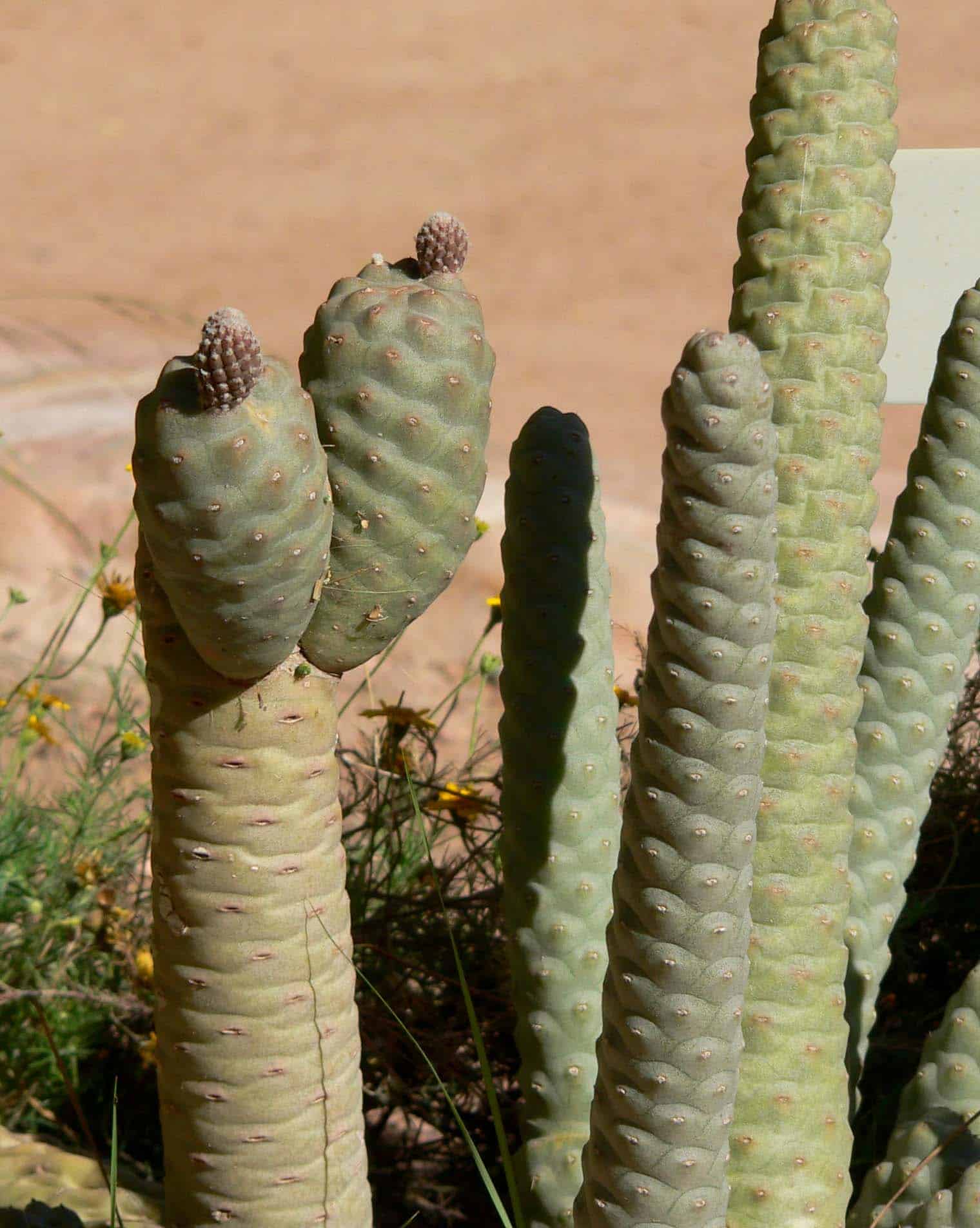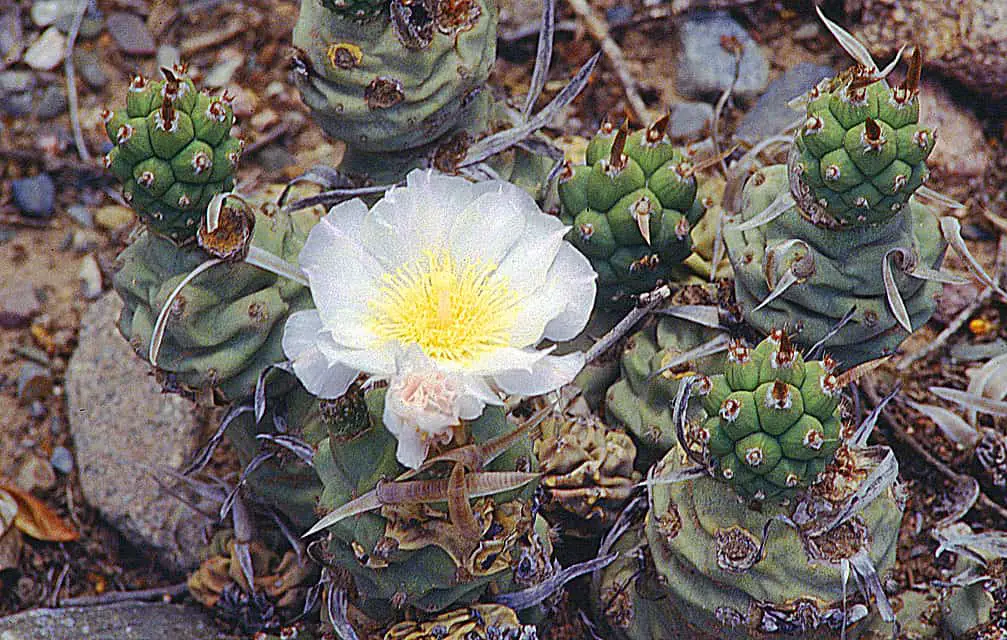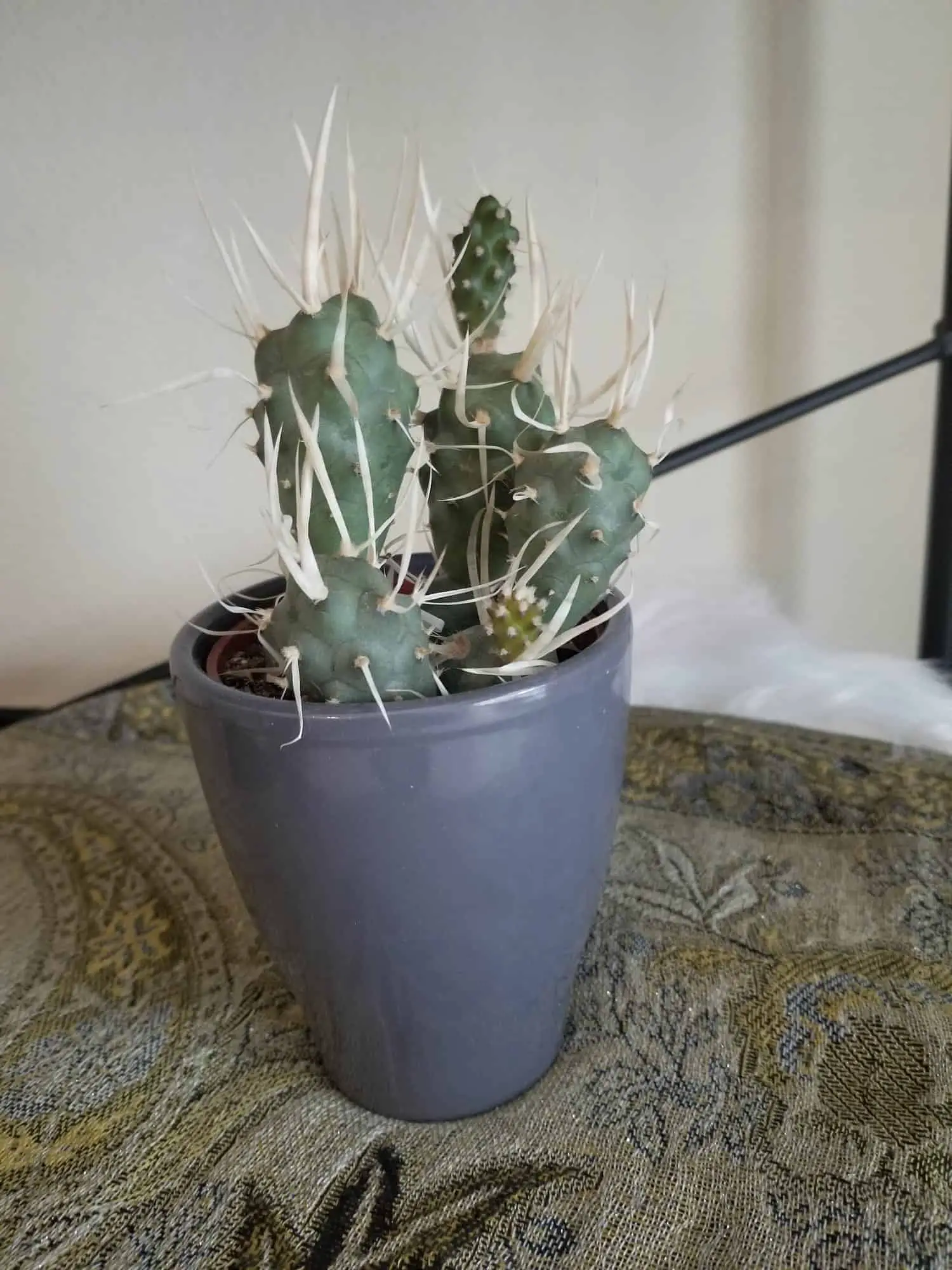Tephrocactus articulatus var. papyracanthus, which is commonly known as Paper Spine Cactus, has long, flat spines that look like paper (hence the name Paper Spine Cactus). As the spines grow longer, they begin to curl. Paper Spine Cacti are comprised of small, oval segments that fall off of the plant fairly easily. For this reason, these plants typically do not grow taller than 12 inches. I recently purchased a Paper Spine Cactus plant from Trader Joe’s, and I am obsessed! To ensure that I provide my new plant with proper care, I did a little research.
To care for Paper Spine Cactus, place it in a location that is exposed to bright light. This plant has watering needs that are typical of succulents. Water the plant thoroughly and allow the soil to dry completely between watering sessions. If your Paper Spine Cactus lives in an environment exposed to medium light, water even less frequently.
The rest of this article will serve as a detailed care guide for Paper Spine Cactus.
Quick Care Guide For Paper Spine Cactus
| Scientific Name | Tephrocactus articulatus var. papyracanthus Opuntia papyracantha |
| Common Name | Paper Spine Cactus |
| Temperature | USDA Hardiness Zones 8b to 10b Can withstand temperatures as low as 30°F but not frost-hardy |
| Lighting | Partial shade to full sun when grown outdoors. Does best next to a south-facing window when grown indoors. |
| Watering | Water thoroughly and allow the soil to dry out completely between watering sessions. Water even less frequently if cactus is grown in medium light conditions. |
| Soil | 70% decomposed granite soil, 30% perlite |
| Fertilization | Fertilize once a year (if growing indoors) with a low-nitrogen (2-4-7 NPK) fertilizer diluted to half strength. Fertilize Paper Spine Cacti living outdoors more frequently. |
| Propagation | Stem segments |
| Toxicity | Non-toxic to pets but glochids can irritate the skin. |
About Paper Spine Cactus
In order to fully understand how to care for Paper Spine Cactus, it is important to learn a little bit about this plant’s native habitat. This is because growers should attempt to mimic the plant’s natural habitat as closely as possible.
Tephrocactus articulatus, which is commonly known as Paper Spine Cactus, grows in many forms in the wild. Backeberg (1977) named eight varieties of Tephrocactus articulatus. There are even forms of Paper Spine Cactus that are spineless.

The Paper Spine Cactus is native to the Andes mountain range in Argentina. The Paper Spine Cactus (Tephrocactus articulatus) is the most widespread species of the Tephrocactus genus with populations extending from the Mendoza province in west-central Argentina through all of the northwestern provinces as far north as Salta.
The native habitat of the Paper Spine Cactus is dry and often sparsely vegetated. The Paper Spine Cactus is native to a region that typically receives less than 10 inches of rain each year. Most of this precipitation falls during the summer months (November to March), so the Paper Spine Cactus has adapted to survive without water for extended periods of time. The temperature typically varies from 35°F to 90°F and is rarely below 30°F or 95°F.
Paper Spine Cactus Blooms

Paper Spine Cactus blooms beautiful white flowers. These flowers will only last for 24 hours, but they are a treat for the patient grower. To encourage your Paper Spine Cactus flower, expose your plant to full sun and keep it outside during the hot, summer months. The warmer weather and longer days trigger flowering in Paper Spine Cactus.
Safely Handling Paper Spine Cactus
I highly recommend wearing leather gloves when handling Paper Spine Cactus. Although the “paper” spines are not a threat, the smaller spines surrounding the base of the paper spine, which are called glochids, can easily get lodged in your skin. Because glochids are so small, they can be difficult to remove from skin.
In my experience, the best way to remove glochids from your skin is to use tweezers. Alternatively, you can try applying Duct Tape to the affected area and removing it.
Lighting Requirements For Paper Spine Cactus
Like many other cacti, Paper Spine Cactus does best if it is exposed to partial shade or full sun. If grown indoors, Paper Spine Cactus should (ideally) be placed next to a south-facing window that is exposed to bright sunlight. However, I have found that my Paper Spine Cactus does okay in medium light as long as I cut back on the watering.
Water Requirements For Paper Spine Cactus
The Paper Spine Cactus has water requirements that are typical of succulents. They do best when watered thoroughly after the soil is allowed to dry completely. This is often referred to as the soak and dry method of watering. Like many other species of cacti, the Paper Spine Cactus does not require a lot of water, especially if you keep your plant indoors. For this reason, it is best to err on the side of underwatering to avoid root rot.
If you are growing Paper Spine Cactus indoors, it is important to remember that cacti exposed to less sunlight should be watered less frequently. In other words, less light means less water. If your Paper Spine Cactus is not growing in full sun, allow the soil profile to dry out completely and remain dry for 4-5 days between watering sessions. This practice will prevent rotting.
Best Soil Mix For Paper Spine Cactus
Like other cacti, Paper Spine Cactus should be grown in well-draining soil to avoid root rot and overwatering. A good soil mix for Paper Spine Cactus would be comprised of 70% decomposed granite soil and 30% perlite. Paper Spine Cactus will grow well in containers or in the ground.
Ideal Temperature Range For Paper Spine Cactus
Paper Spine Cactus can be grown outdoors in USDA Hardiness Zones 8b to 10b. These plants can withstand temperatures as low as 30°F, but they are not frost-hardy. If you live in a place that experiences cold winters, it is best to bring your Paper Spine Cactus indoors before the first frost.
Fertilizing Paper Spine Cactus
The Paper Spine Cactus is a fairly slow-growing plant. Fertilizing your cactus is a way to help your plant grow a little more quickly. Although most cacti will do just fine without fertilizer, adding a little fertilization into your care routine can make your cactus look healthier and even more beautiful.
How often should I fertilize my Paper Spine Cactus?
If you are growing your Paper Spine Cactus indoors, I recommend only fertilizing your plant once per year. After fertilizing, take your indoor plant outside and place it in a spot that is exposed to partial shade. This will give your plant a quick boost without the risk of burn.
Paper Spine Cacti that are grown outdoors can be fertilized more frequently. However, excessive fertilizer can cause slow growth and poor root development.
When should I fertilize my Paper Spine Cactus?
The best time to fertilize a cactus is right before it goes into its active growing season. For the Paper Spine Cactus, this is during early spring. This will trigger new growth during the growing season.
What fertilizer works best for Paper Spine Cactus?
Like other cacti, Paper Spine Cactus is not a heavy feeder. For this reason, it responds to fertilizers that are diluted to half or quarter strength. You can use an all-purpose fertilizer diluted to quarter strength to fertilize your Paper Spine Cactus. However, your Paper Spine Cactus will respond best to a water soluble, low-nitrogen fertilizer (e.g., 2-4-7, 1-7-6, 2-4-2).
Propagating Paper Spine Cactus
Paper Spine Cactus is easy to propagate. First, break off a piece of stem or grab one that has fallen off. Then slice off a piece of the stem to expose a flat piece of cactus flesh. If you have rooting hormone, rub a bit of gel rooting hormone on the exposed piece of flesh (to learn more about rooting hormone, check out this article I wrote about using rooting hormone). Then place the cut stem in dry potting soil.
Many succulent growers recommend allowing the cut piece of stem to callous over before planting it in potting soil. This minimizes the chance of exposing the plant to diseases. However, I have never had an issue with immediately planting stem cutting directly in the soil.
NOTE: As previously mentioned, I highly recommend wearing leather gloves when handling your Paper Spine Cactus. This will prevent the glochids (the tiny cactus spines) from getting lodged into your skin.
Is Paper Spine Cactus Toxic?
Like other cacti belonging to the Opuntia genus, Paper Spine Cactus is non-toxic to pets.

